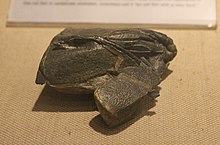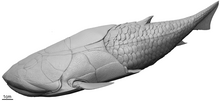Entelognathus: Difference between revisions
Apokryltaros (talk | contribs) m Reverted edits by 2607:FEA8:FDF:2400:AC3C:B627:6AD9:658 (talk) to last version by HaythamKenwai |
Kaltenmeyer (talk | contribs) m clean up, removed stub tag |
||
| (18 intermediate revisions by 12 users not shown) | |||
| Line 5: | Line 5: | ||
| image = Entelognathus-Paleozoological Museum of China.jpg |
| image = Entelognathus-Paleozoological Museum of China.jpg |
||
| image_caption = Holotype, [[Paleozoological Museum of China]] |
| image_caption = Holotype, [[Paleozoological Museum of China]] |
||
| image2 = Reconstruction_of_Entelognathus_primordialis_in_lateral_view.png |
|||
| image2 = Entelognathus.png |
|||
| image2_caption = Life reconstruction of ''Entelognathus primordialis'' |
| image2_caption = Life reconstruction of ''Entelognathus primordialis'' |
||
| parent_authority = Zhu ''et al.'', 2013 <ref name="Zhu2013">{{cite journal|last1=Zhu|first1=Min|last2=Yu|first2=Xiaobo|last3=Ahlberg|first3=Per Erik|last4=Choo|first4=Brian|last5=Lu|first5=Jing|last6=Qiao|first6=Tuo|last7=Qu|first7=Qingming|last8=Zhao|first8=Wenjin|last9=Jia|first9=Liantao|last10=Blom|first10=Henning|last11=Zhu|first11=You’an|title=A Silurian placoderm with osteichthyan-like marginal jaw bones]|journal=Nature|volume=502|issue=7470|year=2013|pages=188–193|issn=0028-0836|doi=10.1038/nature12617|pmid=24067611}}</ref> |
| parent_authority = Zhu ''et al.'', 2013 <ref name="Zhu2013">{{cite journal|last1=Zhu|first1=Min|last2=Yu|first2=Xiaobo|last3=Ahlberg|first3=Per Erik|last4=Choo|first4=Brian|last5=Lu|first5=Jing|last6=Qiao|first6=Tuo|last7=Qu|first7=Qingming|last8=Zhao|first8=Wenjin|last9=Jia|first9=Liantao|last10=Blom|first10=Henning|last11=Zhu|first11=You’an|title=A Silurian placoderm with osteichthyan-like marginal jaw bones]|journal=Nature|volume=502|issue=7470|year=2013|pages=188–193|issn=0028-0836|doi=10.1038/nature12617|pmid=24067611|bibcode=2013Natur.502..188Z |s2cid=4462506 }}</ref> |
||
| taxon = Entelognathus primordialis |
| taxon = Entelognathus primordialis |
||
| authority = Zhu ''et al.'', 2013 |
| authority = Zhu ''et al.'', 2013 |
||
}} |
}} |
||
'''''Entelognathus primordialis''''' (“primordial complete jaw”) is |
'''''Entelognathus primordialis''''' (“primordial complete jaw”) is an early [[placoderm]] from the late [[Silurian]] ([[Ludlow epoch]]) of [[Qujing]], [[Yunnan]], 419 million years ago.<ref name=Barford2013>{{cite journal | journal = Nature | url = http://www.nature.com/news/ancient-fish-face-shows-roots-of-modern-jaw-1.13823 | title = Ancient fish face shows roots of modern jaw |first= Eliot |last= Barford | date = 25 September 2013 |access-date = 26 September 2013 |doi= 10.1038/nature.2013.13823 | s2cid = 87470088 }}</ref><ref name="Zhu2013" /> |
||
A team led by Min Zhu of the Academy of Sciences' [[Institute of Vertebrate Paleontology and Paleoanthropology]] in Beijing discovered the intact, articulated fossil in rock formations at [[Xiaoxiang]] reservoir. |
A team led by Min Zhu of the Academy of Sciences' [[Institute of Vertebrate Paleontology and Paleoanthropology]] in Beijing discovered the intact, articulated fossil in rock formations at [[Xiaoxiang]] reservoir. |
||
==Specimen and taxonomy== |
==Specimen and taxonomy== |
||
[[File:Entelognathus IVPP V32322 cropped.png|left|thumb|Paratype specimen IVPP V32322 with scales and fin spines preserved]] |
|||
The holotype of ''E. |
The holotype of ''E. primordialis'' is the uncrushed and mostly intact anterior half of an individual with the articulating head and trunk armor preserved in three dimensions. The holotype is about {{convert|11|cm}} long, and the live animal is estimated to have been over {{convert|20|cm|0|abbr=on}} long. In overall form, the animal resembles primitive [[arthrodire]]s, but the anatomy of the jaws strongly suggests the anatomies of [[bony fish]] and [[tetrapod]]s. Specifically, this is the first stem gnathostome with dermal marginal jaw bones. These bones are the [[premaxilla]], [[maxilla]], and [[dentary]].<ref name="Zhu2013" /> Most known placoderms had simple beak-like jaws made of bone plates.<ref name="Barford2013" /> In 2023, newly described articulated specimen is shown, which have preserved large scales some of which are rhomboid, and fin spines on dorsal and anal fins (the latter of which was a trait that was previously only found in stem-group [[chondrichthyes]]).<ref>{{Cite journal |last=Cui |first=Xindong |last2=Friedman |first2=Matt |last3=Yu |first3=Yilun |last4=Zhu |first4=You-an |last5=Zhu |first5=Min |date=2023-11-22 |title=Bony-fish-like scales in a Silurian maxillate placoderm |url=https://www.nature.com/articles/s41467-023-43557-9 |journal=Nature Communications |language=en |volume=14 |issue=1 |pages=7622 |doi=10.1038/s41467-023-43557-9 |issn=2041-1723|doi-access=free |pmc=10665347 }}</ref> |
||
The researchers' cladistic diagram suggests that ''E. |
The researchers' cladistic diagram suggests that ''E. primordialis'' forms a [[polytomy]] with arthrodires, [[ptyctodont]]s, and all advanced [[gnathostome]]s (namely bony fish, tetrapods, [[acanthodians]], and chondrichthyes).<ref name="Zhu2013" /> |
||
| ⚫ | |||
==Etymology== |
==Etymology== |
||
| Line 26: | Line 26: | ||
==Evolutionary significance== |
==Evolutionary significance== |
||
Prior to the discovery of ''Entelognathus'', scientists assumed that the last common ancestor of jawed vertebrates was a shark-like animal, with no distinct jawbones, and that modern jaws evolved in early bony fishes. This discovery shows that modern jaws evolved earlier. It is possible that Chondrichthyes started with distinct jaws and then dispensed with them. This has been called the earliest known animal with what looks like a face.<ref name=Barford2013/><ref name= Friedman2013>{{cite journal |title=News & Views: Palaeontology: A jaw-dropping fossil fish |first= Matt |last= Friedman |author2=Martin D. Brazeau |year=2013 |journal=Nature |volume= 502 |pages= 175–177 |doi= 10.1038/nature12690 |doi-access= free }}</ref> |
Prior to the discovery of ''Entelognathus'', scientists assumed that the last common ancestor of jawed vertebrates was a shark-like animal, with no distinct jawbones, and that modern jaws evolved in early bony fishes. This discovery shows that modern jaws evolved earlier. It is possible that Chondrichthyes started with distinct jaws and then dispensed with them. This has been called the earliest known animal with what looks like a face.<ref name=Barford2013/><ref name= Friedman2013>{{cite journal |title=News & Views: Palaeontology: A jaw-dropping fossil fish |first= Matt |last= Friedman |author2=Martin D. Brazeau |year=2013 |journal=Nature |volume= 502 |issue= 7470 |pages= 175–177 |doi= 10.1038/nature12690 |pmid= 24067615 |doi-access= free }}</ref> |
||
== Gallery == |
|||
<gallery heights="120"> |
|||
File:Maxillate placoderms lateral view diagram.png|Diagram with other maxillate placoderms in lateral view |
|||
File:Maxillate placoderms dorsal view diagram.png|Diagram with other maxillate placoderms in dorsal view |
|||
| ⚫ | |||
File:Video of the 3D reconstruction of Entelognathus primordialis.webm|Video of 3D reconstruction |
|||
</gallery> |
|||
== See also == |
== See also == |
||
| Line 38: | Line 46: | ||
==External links== |
==External links== |
||
* [http://news.nationalgeographic.com/news/2013/09/130925-fish-fossil-paleontology-science-evolution-face/ National Geographic - Fish fossil has oldest known face, may influence evolution] |
* [https://archive.today/20130926075233/http://news.nationalgeographic.com/news/2013/09/130925-fish-fossil-paleontology-science-evolution-face/ National Geographic - Fish fossil has oldest known face, may influence evolution] |
||
* [http://in.reuters.com/article/us-china-fossil-idINBRE98P05420130926 Reuters - Fossil fish find in China fills in evolutionary picture] |
* [http://in.reuters.com/article/us-china-fossil-idINBRE98P05420130926 Reuters - Fossil fish find in China fills in evolutionary picture] |
||
* [http://blogs.discovermagazine.com/d-brief/2013/09/25/first-jawed-fish-had-one-ugly-face/#.UkPnUxCgRdU Discover Magazine - First jawed fish had one ugly face] |
* [http://blogs.discovermagazine.com/d-brief/2013/09/25/first-jawed-fish-had-one-ugly-face/#.UkPnUxCgRdU Discover Magazine - First jawed fish had one ugly face] {{Webarchive|url=https://web.archive.org/web/20131003085701/http://blogs.discovermagazine.com/d-brief/2013/09/25/first-jawed-fish-had-one-ugly-face/#.UkPnUxCgRdU |date=2013-10-03 }} |
||
* [https://www.bbc.co.uk/news/world-asia-china-24296362 Scientist hails 'jaw-dropping' fish fossil discovery] (BBC, 2013-09-27) |
* [https://www.bbc.co.uk/news/world-asia-china-24296362 Scientist hails 'jaw-dropping' fish fossil discovery] (BBC, 2013-09-27) |
||
| Line 49: | Line 57: | ||
[[Category:Placoderms of Asia]] |
[[Category:Placoderms of Asia]] |
||
[[Category:Silurian fish of Asia]] |
[[Category:Silurian fish of Asia]] |
||
[[Category: |
[[Category:Enigmatic placoderm taxa]] |
||
[[Category:Prehistoric animals of China]] |
[[Category:Prehistoric animals of China]] |
||
[[Category:Transitional fossils]] |
[[Category:Transitional fossils]] |
||
[[Category:Fossil taxa described in 2013]] |
[[Category:Fossil taxa described in 2013]] |
||
[[Category:2013 in China]] |
[[Category:2013 in China]] |
||
{{Placoderm-stub}} |
|||
Latest revision as of 23:56, 21 January 2024
| Entelognathus primordialis Temporal range: Late Silurian
| |
|---|---|

| |
| Holotype, Paleozoological Museum of China | |

| |
| Life reconstruction of Entelognathus primordialis | |
| Scientific classification | |
| Domain: | Eukaryota |
| Kingdom: | Animalia |
| Phylum: | Chordata |
| Class: | †Placodermi |
| Order: | †incertae sedis |
| Genus: | †Entelognathus Zhu et al., 2013 [1] |
| Species: | †E. primordialis
|
| Binomial name | |
| †Entelognathus primordialis Zhu et al., 2013
| |
Entelognathus primordialis (“primordial complete jaw”) is an early placoderm from the late Silurian (Ludlow epoch) of Qujing, Yunnan, 419 million years ago.[2][1]
A team led by Min Zhu of the Academy of Sciences' Institute of Vertebrate Paleontology and Paleoanthropology in Beijing discovered the intact, articulated fossil in rock formations at Xiaoxiang reservoir.
Specimen and taxonomy[edit]

The holotype of E. primordialis is the uncrushed and mostly intact anterior half of an individual with the articulating head and trunk armor preserved in three dimensions. The holotype is about 11 centimetres (4.3 in) long, and the live animal is estimated to have been over 20 cm (8 in) long. In overall form, the animal resembles primitive arthrodires, but the anatomy of the jaws strongly suggests the anatomies of bony fish and tetrapods. Specifically, this is the first stem gnathostome with dermal marginal jaw bones. These bones are the premaxilla, maxilla, and dentary.[1] Most known placoderms had simple beak-like jaws made of bone plates.[2] In 2023, newly described articulated specimen is shown, which have preserved large scales some of which are rhomboid, and fin spines on dorsal and anal fins (the latter of which was a trait that was previously only found in stem-group chondrichthyes).[3]
The researchers' cladistic diagram suggests that E. primordialis forms a polytomy with arthrodires, ptyctodonts, and all advanced gnathostomes (namely bony fish, tetrapods, acanthodians, and chondrichthyes).[1]
Etymology[edit]
The generic name translates as "complete jaw", referring to how the animal had a complete set of dermal marginal jaw bones. The specific name translates as "primordial".
Evolutionary significance[edit]
Prior to the discovery of Entelognathus, scientists assumed that the last common ancestor of jawed vertebrates was a shark-like animal, with no distinct jawbones, and that modern jaws evolved in early bony fishes. This discovery shows that modern jaws evolved earlier. It is possible that Chondrichthyes started with distinct jaws and then dispensed with them. This has been called the earliest known animal with what looks like a face.[2][4]
Gallery[edit]
-
Diagram with other maxillate placoderms in lateral view
-
Diagram with other maxillate placoderms in dorsal view
-
Pair (middle background) among fauna from the Kuanti Formation including Sparalepis tingi (foreground), numerous conodonts, and Megamastax (background)
-
Video of 3D reconstruction
See also[edit]
References[edit]
- ^ a b c d Zhu, Min; Yu, Xiaobo; Ahlberg, Per Erik; Choo, Brian; Lu, Jing; Qiao, Tuo; Qu, Qingming; Zhao, Wenjin; Jia, Liantao; Blom, Henning; Zhu, You’an (2013). "A Silurian placoderm with osteichthyan-like marginal jaw bones]". Nature. 502 (7470): 188–193. Bibcode:2013Natur.502..188Z. doi:10.1038/nature12617. ISSN 0028-0836. PMID 24067611. S2CID 4462506.
- ^ a b c Barford, Eliot (25 September 2013). "Ancient fish face shows roots of modern jaw". Nature. doi:10.1038/nature.2013.13823. S2CID 87470088. Retrieved 26 September 2013.
- ^ Cui, Xindong; Friedman, Matt; Yu, Yilun; Zhu, You-an; Zhu, Min (2023-11-22). "Bony-fish-like scales in a Silurian maxillate placoderm". Nature Communications. 14 (1): 7622. doi:10.1038/s41467-023-43557-9. ISSN 2041-1723. PMC 10665347.
- ^ Friedman, Matt; Martin D. Brazeau (2013). "News & Views: Palaeontology: A jaw-dropping fossil fish". Nature. 502 (7470): 175–177. doi:10.1038/nature12690. PMID 24067615.
External links[edit]
- National Geographic - Fish fossil has oldest known face, may influence evolution
- Reuters - Fossil fish find in China fills in evolutionary picture
- Discover Magazine - First jawed fish had one ugly face Archived 2013-10-03 at the Wayback Machine
- Scientist hails 'jaw-dropping' fish fossil discovery (BBC, 2013-09-27)



